MXA’S 2014 YAMAHA YZ250F MOTOCROSS TEST: EVERYBODY LOVES AN UNDERDOG
FIRST AND FOREMOST, IS THE 2014 YAMAHA YZ250F BETTER THAN THE 2013 YZ250F?
A: Yes! The MXA wrecking crew has been waiting quite a few years to applaud Yamaha for unveiling an all-new YZ250F. Though this bike comes several years after we began voicing the need for Yamaha to up the ante—and Yamaha admitted that they were late to the game. The 2014 YZ250F is changed in every conceivable way.
It’s one thing to release a new bike, but quite another to actually get it right. We believe that the 2014 Yamaha YZ250F is much improved in many areas, though it’s not a perfect machine. Regardless, we’d choose the 2014 model over any previous YZ250F without thinking twice.

Q: HOW MANY CHANGES WERE MADE TO THE 2014 YAMAHA YZ250F?
A: The real question is, how many parts does the 2014 YZ250F share with the previous model? We were hard-pressed to find the commonalities, aside from the front fender, front number plate, bottom triple clamp, rear wheel, brakes and fork guards.
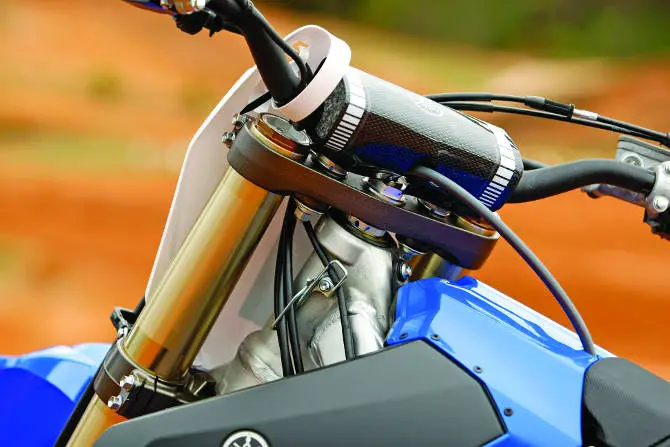
Q: WHAT WERE THE KEY CHANGES MADE TO THE 2014 YZ250F?
A: If we discussed every single change made to the 2014 Yamaha YZ250F, then we would run out of time and your patience. The list is extensive—from the updated frame to the downdraft fuel injection—so we’ve boiled the list down to the most important updates.
(1) Engine. The most obvious change is that the cylinder is now rearward slanting, with the exhaust ports facing where the carburetor used to be. There’s also the four-valve layout, narrower valve angle, high-lift camshafts, shorter and lighter single-ring piston, smaller crankshaft, offset cylinder and a more efficient oiling system.
(2) Electronic fuel injection. It took Yamaha six years, but the Keihin FCR carburetor is now extinct in the four-stroke market. The YZ250F was the last holdout. Yamaha finally appeased consumers by using a 44mm Keihin throttle body with a 10-hole injector and high-pressure battery-less electric pump to deliver fuel to the engine. No more jetting. No more guesswork. As a result, the ignition can be customized with the GYTR Power Tuner.
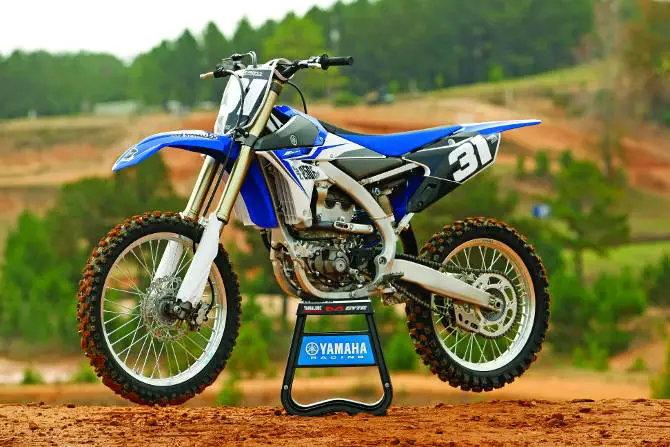
(3) Chassis. Every part of the chassis is new, including the engine brackets and oddly shaped subframe. Note that the dimensions of the steering head, rake and trail are the same as the 2013 model, but the flex characteristics are different. Yamaha’s engineers focused heavily on improving the centralization of mass by moving the weight (muffler, gas tank and engine) closer to the middle of the YZ250F. They succeeded.
(4) Suspension. The YZ250F still comes with Kayaba’s SSS (Speed Sensitive System) suspension, but the spring rates have been stiffened and the damping changed for more ride control. The front axle diameter has been increased by 2mm for greater rigidity, and the inner fork tubes have undergone a new polishing process for greater sheen and less stiction.
(5) Styling. You’d have to be blind in order to miss the radically changed body styling on the YZ250F. From the air intake ducts to the embedded graphics to hidden gas cap under the seat, the YZ250F is unlike any of its predecessors. It’s worth mentioning that every plastic piece on the YZ250F can be shared with the YZ450F.
Q: WHY DID YAMAHA DROP-KICK THE KEIHIN FCR CARBURETOR?
A: To be blunt, Yamaha ditched the carburetor because of you. Yes, we’re talking to you; that is unless you’re a two-stroke diehard, in which case you wouldn’t be reading this bike test anyway. Back to the question at hand. Electronic Fuel Injection (EFI) has become the standard fuel delivery system on all major four-strokes. Perhaps you’ll remember that the 2008 Suzuki RM-Z450 was the first bike to come out of the crate with EFI. That was six years ago, which equates to a millennium when it comes to technological advancements.
It is important to note, especially since the YZ250F was the last holdout for carburetors, that fuel injection doesn’t make more horsepower than a carb. Far from it. What is does do it help the manufacturer’s bottom line, because once you invest in fuel injecting one model in your product line, you might as well fuel inject all of them to get the benefits of economy of scale. Fuel-injected bikes have better throttle response, but for big horsepower numbers—a carb is better. Sadly, Yamaha never tried to get big numbers out of the Keihin-aspirated YZ250F. They stuck with a mellow low-to-mid powerband—but their National race bikes were rocketships—proven by Cooper Web and Jeremy Martin last year. The carb is gone now—and so is your ability to fix whatever ails your bike with regular tools. One more nail in the owner of friendly days of backyard mechanics.

Yamaha had been testing EFI for years before finally pulling the trigger for 2014. In fact, the 2010 YZ250F was very close to receiving fuel injection, but at the eleventh hour their engineers pulled the plug. Why? It came down to a lack of performance. To quote a Yamaha representative, “Electronic Fuel Injection made an improvement [on the older models], but it wasn’t revolutionarily better. So, for 2014 we developed a bike that would work in conjunction with our downdraft EFI design that has huge potential now and for the future. We believe that the competition will eventually reach a limit with the conventional EFI layout.”
Q: HOW DOES THE 2014 YAMAHA YZ250F COMPARE TO LAST YEAR’S MODEL ON THE DYNO?
A: The 2014 YZ250F stomps the yard. Yamaha has managed to join the esteemed 40-plus-horsepower club. Along with the KTM 250SXF (42.89 ponies) and Kawasaki KX250F (41.16 ponies), the YZ250F, at 40.61 horsepower, is in the mix among the powermongers.
This is a huge step forward for Yamaha. To compare, the 2013 YZ250F produced a measly 37.13 ponies at 11,500 rpm with 19.55 foot-pounds of torque. The 2014 engine pumps out 40.61 ponies at 12,100 rpm with 20.28 foot-pounds of torque. Such a remarkable improvement can be attributed to the new cylinder head, engine architecture, layout, camshafts, EFI, piston and crankshaft. Brilliant!
Q: HOW FAST IS THE 2014 YZ250F?
A: Let’s take a walk down memory lane and remind you what we said about the 2013 YZ250F: “The engine is a warhorse. It is bulletproof. But why shouldn’t it be? It’s not stressed enough.” Simply stated, the old YZ250F powerplant lacked the zest and speed to keep pace with other bikes on the track.
Yamaha went back to the drawing board. Their engineers were determined to open up the powerband and give it more depth from bottom-end hit to unbridled top-end speed. Additionally, the goal was to give the YZ250F a quick and consistent throttle response (most first-year EFI-equipped bikes have been plagued by a lack of horsepower and a hollow-feeling powerband).
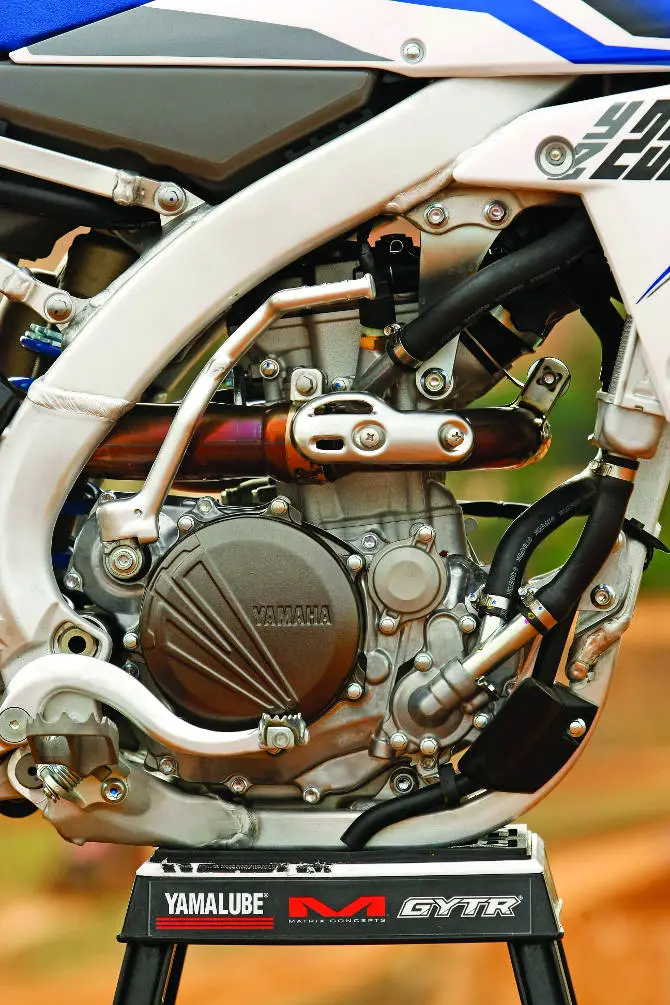
How fast is the 2014 YZ250F? It’s leaps and bounds better than any other YZ250F since it first revolutionized the industry in 2001. Off idle, the 2014 model kicks hard—not to the point of being overwhelming, but it demands respect. As the rpm builds, the engine does its best work, shrieking like a scalded cat on discount house catnip. The bottom-end to midrange transition is superb. Where the old engine was a bottom-end feeder, the new powerplant has considerably more breadth and usability. Test riders feel that the engine is sweetest in the midrange—from 8000 rpm to 10,000 rpm—but is is flat on top. Top-end power isn’t the engine’s best trait, but that’s because it’s so good at lower rpm. We don’t consider this to be a bad thing.
What type of rider will get the most benefit out of the YZ250F engine? That’s a trick question, because all skill levels will be thrilled with the powerband. Our slower riders appreciated the bottom-end usability to midrange pull. Intermediates on up to the Pro ranks raved about the meaty midrange and over-rev, though they did feel that the top-end power was lacking in comparison to the KTM 250SXF and KX250F. Regardless, the YZ250F engine was a hit (both literally and figuratively).
Q: WHAT ARE THE DEFINING CHARACTERISTICS OF THE 2014 YAMAHA YZ250F?
A: As bland as the older-generation YZ250F had become, the 2014 model turns conventional wisdom upside down. The all-new bike has made a big splash, and it has done so for these reasons:
(1) Rearward cylinder. Although this design seems dated in the 450 class (Yamaha unveiled this unique layout in the 2010 YZ450F), it’s brand new on a 250 four-stroke. The profile isn’t conventional, but it’s also not as unusual as the 2010 Husaberg FX450, whose cylinder was laid down at a 70-degree angle. That was a bad idea, whereas the YZ250F engine concept is excellent.
(2) Suspension. The YZ250F is the only bike in its class to come with Kayaba SSS suspension. The damping is determined by the speed at which the piston moves through the cartridge rod—not its position in the stroke of the fork. For 2014 Yamaha upped the spring rates on the forks and shock for the race-inspired crowd. It’s no secret that the MXA wrecking crew favors Kayaba SSS suspension. At a time when other manufacturers are leapfrogging to newer suspension technology, such as Showa’s Separate Function fork and Kayaba’s Pneumatic Spring fork, the YZ250F is sticking with a sure thing.
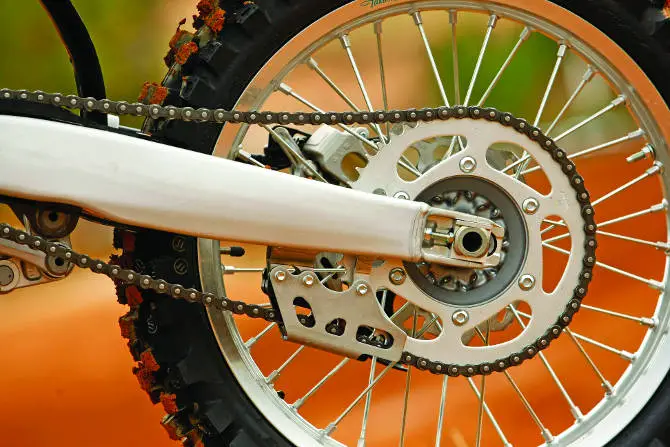
(3) Weight. It wasn’t a surprise last year when the YZ250F weighed the least out of all 250 four-strokes. At 218 pounds, it wasn’t weighted down with EFI and its subsequent electronics, magnets and fuel pump. The fact that the YZ250F only gained 3 pounds for 2014 and is still the lightest bike in the class is remarkable. To put it into perspective, the 221-pound YZ250F weighs 10 pounds less than the KTM 250SXF.
(4) Styling. Who can ignore the hidden gas cap, front-intake air-filter position, tightly angled subframe, in-mold graphics and sharp edge-design elements? The YZ250F doesn’t resemble any other bike, except for the YZ450F, which it could be mistaken for.
Q: WHAT DID WE DO TO IMPROVE THE 2014 YZ250F?
A: The YZ250F’s faults are few, but there are still issues that will need to be resolved. Yamaha owners will be happy to hear that these areas can be fixed with ease and a modicum of money.
(1) Mapping. Just as on the 2014 YZ450F, the YZ250F greatly benefits from mapping changes. We love the GYTR Power Tuner ($279.95, your local dealer), because we were able to make minute changes to many areas of the engine. Yamaha had several preprogrammed maps that peaked our interest—one labeled aggressive and another that softened bottom-end and midrange hit. The aggressive map richened the fuel mixture and advanced the timing, while the hardpack map did the exact opposite. On most track surfaces we preferred the aggressive map because it livened up the powerband. Although top-end power and over-rev were sacrificed, they were worth the trade-off. On a faster track we would elect to run the hardpack map. Though midrange hit was lessened, we found that top-end power and over-rev were boosted. Note that both of these maps are available on Yamaha’s website.
(2) Front brake. Unless your bike starts with “K” and ends with “TM,” then you’re in the market for an oversize front-brake rotor. The YZ250F front brake did a fair job at keeping the front end from drifting when dragging it through ruts, but it was weak when immediate stopping power was necessary. Don’t waste your time trying to bleed the brake, using different brake pads, scuffing up the rotor or hoping that the brake will improve over time. Nothing short of investing in an oversize brake rotor will work.
(3) Handling. Don’t be fooled by the performance of the 2014 YZ250F on a smooth track. In perfect conditions the YZ250F handles like a fighter jet. Once braking bumps and square edges form, we discovered that the front end hunted and pecked at the entrance to corners. The sensation was very similar to the YZ450F, only much less drastic. Test riders felt reasonably confident that the front end would stick, but sometimes it didn’t. We realized that finding the correct race sag and fork-leg height were very important. We found comfort once the YZ250F chassis was balanced front and rear.
Q: WHAT DO WE HATE?
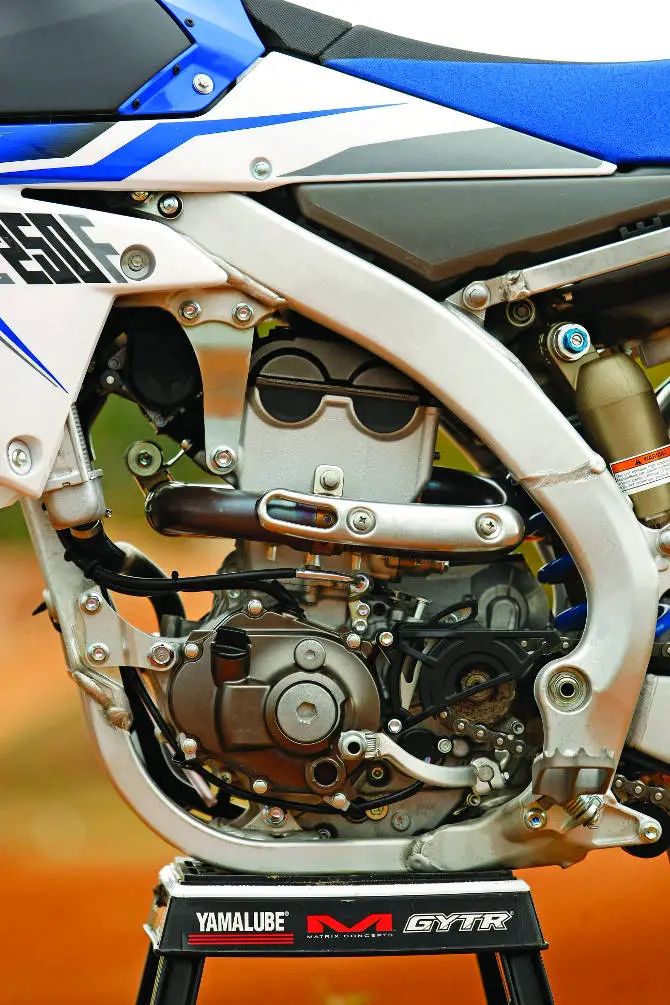
A: The hate list:
(1) Handlebars. The oversize handlebars are a nice touch, but the bend and sweep weren’t favored by any test rider. We switched to a Renthal Twinwall 997 bend and immediately noticed a change for the better.
(2) Front brake. The YZ250F front brake should be taken as seriously as Ernest P. Worrell. Hey, Vern, know what we mean?
(3) Exhaust pipe. It’s neat in design but a nightmare to remove, especially the header piece that wraps around the cylinder.
(4) Brackets. It’s nitpicky, but the aluminum brackets fall out when removing the YZ250F plastic and are a pain to line up when it comes time to reinstall the plastic.
Q: WHAT DO WE LIKE?

A: The like list:
(1) Engine. This isn’t your grandfather’s engine anymore. We loved the throttle response and breadth of power. Plus, it makes over 40 horsepower. Awesome!
(2) Suspension. The stiffer spring rates will be too much for light riders, but the Kayaba SSS is built for speed.
(3) GYTR Power Tuner. Yamaha has the most intuitive mapping software on the market. It’s easy to use and works amazingly well.
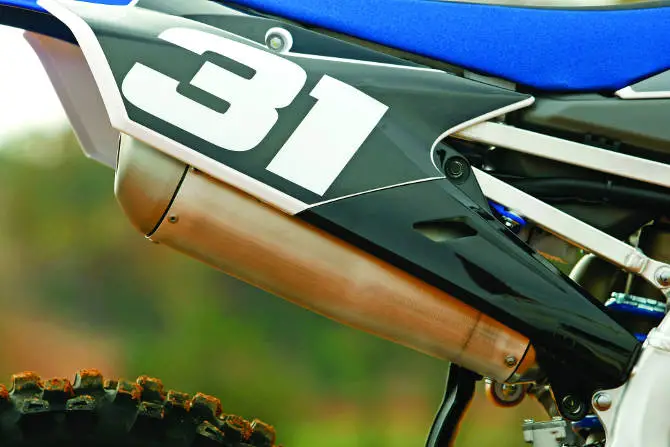
(4) Tires. Bridgestone’s 403/404 rubber combination is pure gold. We love these sneakers because they work well in a wide range of conditions.
(5) Updates. After years of complaining, we finally got our wish. We’re overjoyed to report that the YZ250F is new from the ground up. More importantly, Yamaha knocked it out of the ballpark.
Q: WHAT DO WE REALLY THINK?
A: What a difference a year makes! Heck, what a difference six years makes! Yamaha kept punting this ball down the field when the other bikes, specifically the Kawasaki KX250F, were throwing touchdowns. Yamaha wants us to believe that, like a glass of fine wine, they didn’t want to pick any grape before its time. Balderdash! They sat on their old design for too many years to have us believe that they couldn’t have done this exact same bike in 2010, 2011, 2012 or 2013. Okay, given all of the bike’s positive attributes, we’re happy with what we finally got. And, in the first few laps on the 2014 Yamaha YZ250F, we forgot how long we waited. Kudos to Yamaha for a job well done.
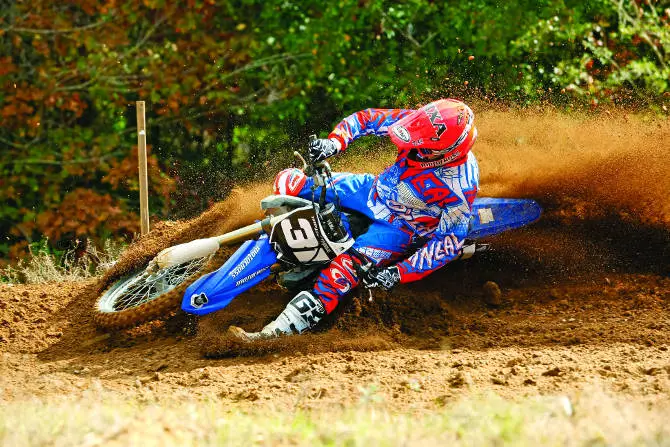
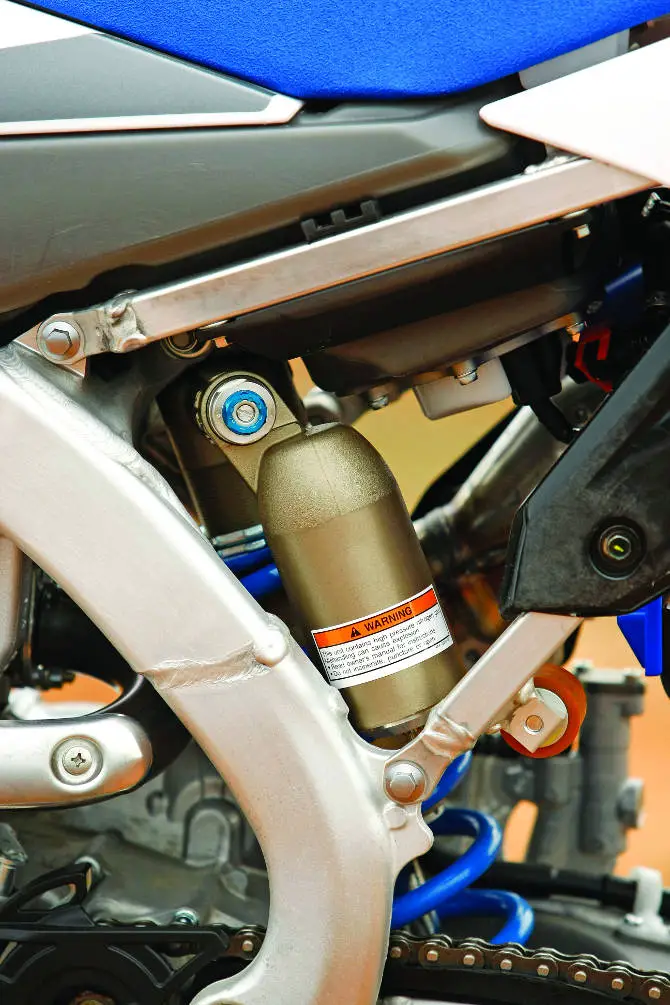
MXA’S 2014 YAMAHA YZ250F SETUP SPECS
This is how we set our 2014 Yamaha YZ250F up for the track. We offer these settings to help steer you in the right direction.
KAYABA SSS FORK SETTINGS
The YZ250F retains Kayaba’s proven SSS suspension. For 2014, Yamaha’s testing department elected to jump up the spring rates. Note that the 2013 fork setup came with 4.5 N/mm rates, while the 2014 model has 4.7 N/mm springs. Front-wheel travel has been increased by 10mm. Also, the lower fork stanchions have undergone a new polishing process for less stiction.
Heavier test riders (175 pounds) raved about the plushness and consistent ramp-up feeling in the forks, although we did soften the compression and slow down the rebound until we found the sweet spot. Lighter riders might find comfort lowering the fork-oil height in increments of 5cc. Lighter fork springs will be necessary for featherweights.
For hardcore racing we recommend this fork setup for the 2014 Yamaha YZ250F (stock specs are in parentheses):
Spring rate: 4.7 N/mm
Oil quantity: 330cc
Compression: 12 clicks out (8 clicks out)
Rebound: 12 clicks out (9 clicks out)
Fork-leg height: 5mm up
Notes: As mentioned above, lighter riders will find comfort lowering the oil height or, at worst case, dropping back to last year’s fork springs. Also, be mindful of fork-leg height, as it’s instrumental in finding chassis balance.
KAYABA SSS SHOCK SETTINGS
As is the case with the Kayaba SSS forks, the shock also received a stiffer spring rate. Yamaha’s goal was to improve performance in high-load situations and provide a more controlled damping character. We are pleased with the stiffer spring, because our heavier testers were on the cusp of needing a spring change on the 2013 shock.
For hardcore racing we recommend this shock setup for the 2014 Yamaha YZ250F (stock specs are in parentheses):
Spring rate: 56.0 N/mm
Race sag: 102mm
Hi-compression: 2 turns out (1-1/3 turns out)
Lo-compression: 12 clicks out (10 clicks out)
Rebound: 12 clicks out (14 clicks out)
Notes: The shock has a tendency to hop under heavy braking and down rough straights. We slowed down the high-speed compression and softened up the low-speed compression.
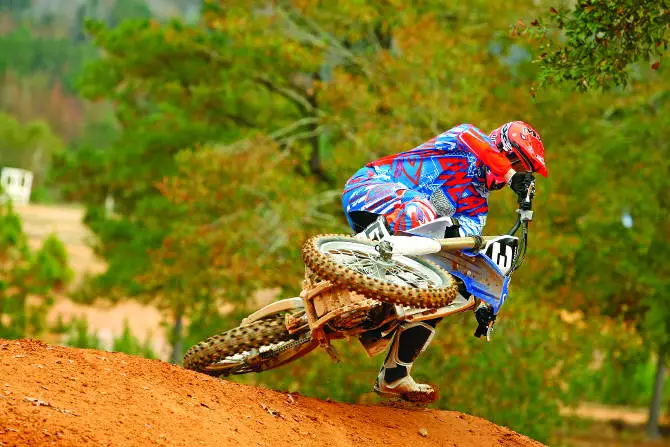






Comments are closed.